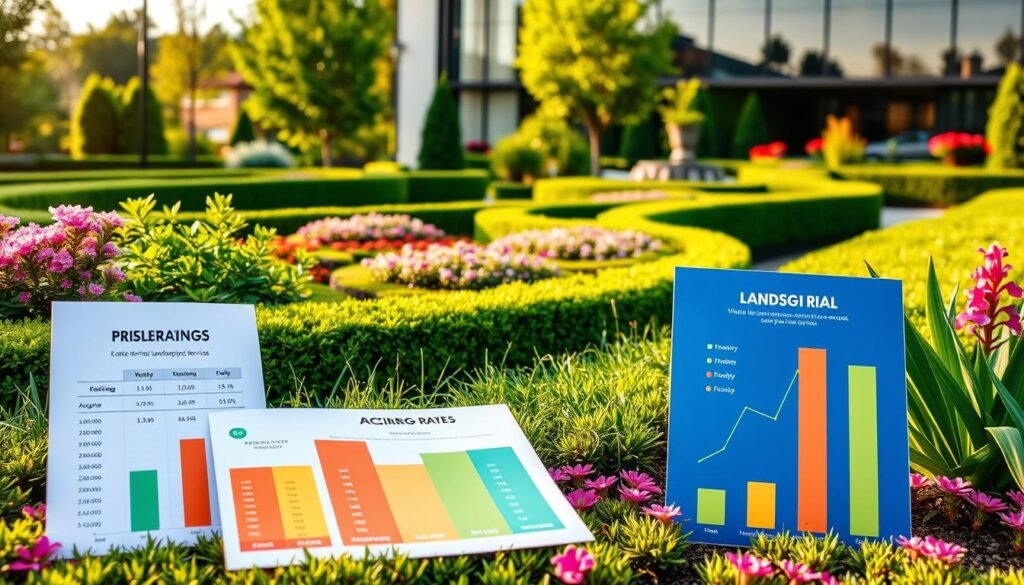Did you know the landscaping industry generates $153 billion annually? With low startup costs and steady demand, turning green spaces into profits is within reach. Entrepreneurs like Ben Ashton prove it’s possible—launching with just $3,000 in equipment and a pickup truck.
This guide breaks down the 8-step framework for launching successfully. From selecting services like synthetic turf installation to mastering seasonal demand, each phase is designed for clarity. Legal setup, pricing strategies, and marketing tactics are covered in detail.
Low barriers to entry make this industry appealing. Basic tools can lead to high-growth opportunities. Whether focusing on residential lawns or commercial projects, flexibility meets profitability.
Key Takeaways
- The landscaping industry offers a $153 billion market opportunity
- Successful launches require minimal initial investment
- Specialized services like turf installation boost profitability
- Legal and pricing strategies are critical for long-term success
- Marketing directly impacts client acquisition and retention
1. Introduction to Starting a Landscaping Business
With $93 billion in annual revenue, the landscaping industry presents a thriving space for entrepreneurs. The National Association of Landscape Professionals reports over 1 million employees nationwide, with year-round demand in warmer climates.
Take Bryan Clayton’s success story: He grew his business from a single push mower to a team of 125 employees. His journey underscores the scalability possible in this field.
New ventures typically choose between residential and commercial services. Residential projects offer steady income, while commercial contracts yield higher per-job revenue. Each requires distinct strategies for client management and scheduling.
Common challenges include equipment maintenance (5–10 hours weekly) and insurance compliance. Investing in professional certifications—like irrigation or sustainable design—can differentiate your services and justify premium pricing.
2. Define Your Landscaping Services
Profit margins vary widely based on the types of landscaping services you provide. Residential projects, like weekly lawn care, yield steady income, while commercial contracts offer larger payouts per job. Your choice impacts equipment needs, staffing, and long-term scalability.
2.1 Residential vs. Commercial Services
Residential clients often need recurring maintenance, such as mowing or leaf removal. Equipment costs start at $12,000 for riding mowers. Commercial projects require heavy-duty tools like $50,000 front-end loaders but deliver higher revenue per contract.
2.2 Specialize in Niche Services
Boost profits by mastering specialized skills. Irrigation systems, for example, require a C-27 license in California. Synthetic turf installation, like Rocky Mountain Turf’s niche, commands 30–40% margins versus 45–60% for basic mowing.
2.3 Assess Local Market Demand
Survey neighborhood HOAs or commercial properties for service gaps. Pesticide application certifications vary by state—research local regulations. Design-focused services attract premium clients but need artistic expertise.
3. Calculate Your Startup Costs
Smart budgeting separates thriving landscaping operations from those that struggle. Initial investments in equipment, licenses, and marketing determine your venture’s scalability. Whether launching with $3,000 in rented tools or a $50,000 fleet, precise planning prevents cash flow pitfalls.
3.1 Equipment Expenses
Commercial-grade equipment ranges from $5,000 for basics to $50,000+ for full crews. A Stihl chainsaw ($300–$800) and Bobcat loader ($25,000+) handle most jobs. Financing options span 3–7 years at 6–12% APR.
Hidden expenses like OSHA-compliant safety gear ($200/employee) add up. Leasing avoids upfront costs but limits long-term equity. A reliable vehicle is critical—used trucks start at $15,000.
3.2 Licensing and Insurance Costs
State licenses vary: California’s C-27 license costs $450, while Texas requires a $115 application fee. General liability insurance averages $1,200 annually. Workers’ comp adds $2–$5 per $100 payroll.
Petrus Landscaping’s $450,000 Department of Labor fine underscores compliance urgency. Bonding (1–3% of project value) protects against client disputes.
3.3 Initial Marketing and Website Setup
A professional website ($1,500–$5,000) boosts credibility. Google Ads budgets start at $500/month for local leads. Yard signs ($100 for 50) and door hangers ($0.15 each) target hyperlocal clients.
Allocate 10–15% of startup funds to branding. ROI tracking tools like Jobber ($49/month) measure campaign effectiveness.
4. Meet Legal and Licensing Requirements
Navigating legal requirements is crucial for protecting your landscaping venture from costly mistakes. A single lawsuit or fine can derail operations. Structured compliance ensures long-term stability and client trust.
4.1 Register Your Business (LLC Recommended)
An LLC limits personal liability if clients or workers sue. A 2022 case study showed sole proprietors lost homes over unpaid judgments. ZenBusiness offers $0 LLC formation (plus state fees).
Corporations suit multi-state operators but require complex filings. LegalZoom’s compliance packages streamline paperwork for $149/year.
4.2 Obtain State-Specific Landscaping Licenses
Utah’s S330 license mandates 2 years’ experience and a $150 fee. Processing takes 4–6 weeks. California’s C-27 license costs $450 and requires a bond.
Some states exempt small operations. Verify local rules—unlicensed contractors face $5,000+ fines.
4.3 Secure General Liability and Workers’ Compensation Insurance
Liability insurance covers property damage claims ($1M policies average $600/year). Thimble offers pay-as-you-go coverage for seasonal dips.
Workers’ comp costs $2.25 per $100 payroll. Skipping it risks six-figure penalties—like Petrus Landscaping’s $450,000 fine.
5. Set Up Your Business Finances
Financial organization is the backbone of any successful landscaping operation. Structuring accounts, taxes, and payments early prevents cash flow gaps and legal headaches. A 2023 IRS report shows 40% of small business failures stem from poor financial management.
5.1 Apply for an Employer Identification Number (EIN)
An EIN legally separates your business from personal finances. The IRS issues them free in 15 minutes online. Use it to open bank accounts, hire employees, and file taxes.
Without an EIN, you risk mixing funds—a red flag for audits. Seasonal operations still need one, even with temporary payroll.
5.2 Open a Business Bank Account
Novo and Bluevine offer no-fee accounts with perks like early direct deposit. Compare features: Novo integrates with Stripe, while Bluevine provides 2.0% interest on balances.
Separate accounts simplify tax filings. The Bank of America® Customized Cash Rewards card earns 3% back on gas—ideal for fleet expenses.
5.3 Choose a Payment Processing System
Square (2.6% + 10¢ per swipe) suits mobile transactions, while Stripe (2.9% + 30¢) excels online. Both sync with accounting software like QuickBooks.
Track sales tax in 45 states with nexus rules. QuickBooks Online automates filings, saving 5+ hours monthly.
6. Price Your Landscaping Services Competitively
Setting the right prices transforms your green services into a profitable venture. The $30–$50 hourly average reflects regional benchmarks, but smart operators adjust for labor, materials, and demand cycles. Data from GreenPal shows dynamic pricing boosts revenue by 22% for seasonal work like snow removal.
6.1 Research Local Competitor Pricing
Analyze three to five established companies in your area. Note their per-project rates for lawn care versus specialty services like irrigation. Commercial contracts often command 15–20% premiums over residential work.
Tools like Angi Pro provide real-time pricing data. In Florida, summer mowing averages $45/hour, while Minnesota winters see 25% discounts.
6.2 Factor in Labor, Equipment, and Overhead Costs
Use this formula: (Labor + Equipment + Overhead) × 1.3 Profit Margin. A $20/hour crew cost with $10 equipment expenses needs $39 pricing to maintain 30% margins.
Track hidden costs like fuel (10–15% of revenue) and truck maintenance. Fixed-price contracts should include 10% contingency buffers for unexpected delays.
6.3 Adjust Pricing for Seasonal Demand
Winter surcharges of 20–30% apply in snowy regions for plowing services. Conversely, offer summer hydration packages in arid climates. Phoenix landscapers report 40% revenue spikes from monsoon-season cleanups.
Upsell high-margin add-ons: Premium mulch brands deliver 20% profits, while native plant installations attract eco-conscious customers.
7. Market Your Landscaping Business Effectively
73% of property owners discover landscapers through online platforms—making marketing essential. A mix of digital strategies and local outreach ensures steady client flow. Prioritize platforms where your target audience actively searches for services.
7.1 Build a Strong Online Presence
A professional website acts as your 24/7 salesperson. Include service pages, client testimonials, and a clear “landscaper near me” call-to-action. Social media amplifies reach—Instagram Reels boost inquiries by 40% for brands showcasing before/after transformations.
7.2 Leverage Local SEO and Google Business Profile
Optimize your Google Business Profile with seasonal offers (e.g., “Spring Cleanup Specials”). Local SEO tactics like geo-tagged blog posts (“Best Landscaping in [City]”) improve search rankings. Consistent NAP (Name, Address, Phone) listings on directories like Angi ($300–$600/year) build credibility.
7.3 Network with Local Contractors and Homeowners
Join the National Association of Home Builders ($275/year) for contractor referrals. Attend HOA meetings to pitch maintenance packages. Yard signs designed in Canva ($2.50 per vinyl sign) turn satisfied clients into walking billboards.
Track results with tools like Jobber to refine your strategy. Focus on high-ROI activities—Bark leads cost $50–$200/month but convert 30% faster than cold calls.
8. Invest in Landscaping Business Tools
Efficient operations in the green industry rely on the right mix of tools and technology. From durable mowers to scheduling software, strategic investments streamline workflows and boost profitability.
8.1 Essential Equipment for Daily Operations
Commercial-grade mowers like Husqvarna’s 48-inch models ($5,000–$7,000) outperform residential units with 5-year warranties. Echo’s handheld trimmers ($200–$500) offer lighter alternatives for tight spaces.
GPS trackers like FleetUp cut fuel costs by 15% through optimized routes. For heavy-duty jobs, EquipmentShare rents mini-excavators for $175/day—ideal for short-term projects.
8.2 Consider Lawn Care Software for Efficiency
Service Autopilot ($129/month) automates invoicing, while Jobber ($299/month) integrates with QuickBooks for real-time profit tracking. Both platforms reduce admin time by 20+ hours monthly.
Mobile apps enable crews to update job statuses instantly. Clients receive automated reminders, improving on-time payment rates by 30%.
8.3 Maintain and Upgrade Tools Over Time
Sharpen mower blades every 25 hours to ensure clean cuts. Lubricate gears weekly to prevent $500+ repairs. Store equipment in climate-controlled spaces to extend lifespans.
Upgrade vehicles every 3–5 years—leasing options like Ford Pro’s plans include maintenance packages. Tax deductions offset 30–50% of costs.
Conclusion
The landscaping business offers a $153 billion market with 45% profit potential for those who plan strategically. Focus on legal protection first—form an LLC and secure insurance bundles to safeguard assets.
Scale smartly by hiring your first employee at $100k revenue. Tools like ZenBusiness simplify expansion with compliance-ready growth packages. Their solutions help streamline operations as demand increases.
Now’s the time to take action. Download our free startup checklist to turn your green-space expertise into a successful venture. Every thriving company begins with one decisive step—make yours today.
FAQ
What services should a new landscaping business offer?
Focus on core services like lawn maintenance, planting, and hardscaping. Specializing in irrigation or design can set you apart. Research local demand to tailor your offerings.
How much does it cost to launch a landscaping company?
Initial expenses include equipment (,000–,000), licensing (0–
FAQ
What services should a new landscaping business offer?
Focus on core services like lawn maintenance, planting, and hardscaping. Specializing in irrigation or design can set you apart. Research local demand to tailor your offerings.
How much does it cost to launch a landscaping company?
Initial expenses include equipment ($5,000–$50,000), licensing ($100–$1,000), and marketing ($500–$5,000). Costs vary based on scale and location.
Is liability insurance necessary for landscapers?
Yes. General liability insurance protects against property damage or injuries. Workers’ comp is also required if hiring employees.
What’s the best legal structure for a landscaping business?
An LLC limits personal liability and simplifies taxes. Sole proprietorships work for solo operators but offer less protection.
How do landscapers attract their first clients?
Create a Google Business Profile, use social media, and network with realtors or contractors. Offer discounts for referrals to boost word-of-mouth.
Should I buy or lease landscaping equipment?
Leasing reduces upfront costs, but buying saves money long-term. Start with essentials like mowers, trimmers, and hand tools.
How do I price landscaping jobs competitively?
Analyze local rates, factor in labor and overhead, and adjust for project complexity. Seasonal pricing can maximize profits during peak demand.
What software helps manage a landscaping business?
Tools like ServiceTitan or Jobber streamline scheduling, invoicing, and payroll. GPS tracking apps optimize route efficiency for crews.
,000), and marketing (0–,000). Costs vary based on scale and location.
Is liability insurance necessary for landscapers?
Yes. General liability insurance protects against property damage or injuries. Workers’ comp is also required if hiring employees.
What’s the best legal structure for a landscaping business?
An LLC limits personal liability and simplifies taxes. Sole proprietorships work for solo operators but offer less protection.
How do landscapers attract their first clients?
Create a Google Business Profile, use social media, and network with realtors or contractors. Offer discounts for referrals to boost word-of-mouth.
Should I buy or lease landscaping equipment?
Leasing reduces upfront costs, but buying saves money long-term. Start with essentials like mowers, trimmers, and hand tools.
How do I price landscaping jobs competitively?
Analyze local rates, factor in labor and overhead, and adjust for project complexity. Seasonal pricing can maximize profits during peak demand.
What software helps manage a landscaping business?
Tools like ServiceTitan or Jobber streamline scheduling, invoicing, and payroll. GPS tracking apps optimize route efficiency for crews.










